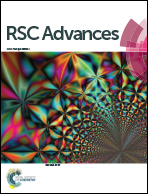Multilayer fluorescent magnetic nanoparticles with dual thermoresponsive and pH-sensitive polymeric nanolayers as anti-cancer drug carriers†
Abstract
A multi-step process was used to synthesize fluorescent folic acid (FA)-conjugated stimuli-responsive magnetic nanoparticles as anti-cancer drug nanocarriers. Sol–gel processing of tetraethyl orthosilicate and fluorescein isothiocyanate-conjugated 3-aminopropyltriethoxysilane was used to synthesize Fe3O4@SiO2–FITC followed by the distillation precipitation polymerization of 2-hydroxyethyl methacrylate and N,N′-methylenebis(acrylamide) to obtain Fe3O4@SiO2@P(HEMA) nanoparticles. Conjugating with FA and RAFT agent, Fe3O4@SiO2@P(HEMA)@P(NIPAAM-co-AA) nanoparticles were synthesized via the polymerization of N-isopropylacrylamide and acrylic acid. The core–shell structure of nanoparticles was revealed via TEM. Furthermore, the progression of each step was studied by means of FT-IR and TGA. VSM and XRD were used to show that the synthesized nanoparticles retain their superparamagnetic properties. The synthesized nanoparticles exhibited dual thermo- and pH-sensitive behaviours. These nanoparticles were used as nanocarriers of the anti-cancer drug doxorubicin via controlled release in simulated physiological and acidic conditions. In addition, the synthesized nanoparticles showed a relatively non-toxic nature to HeLa cells, whereas cell viability decreased significantly when cells were incubated with DOX-loaded nanoparticles.


 Please wait while we load your content...
Please wait while we load your content...